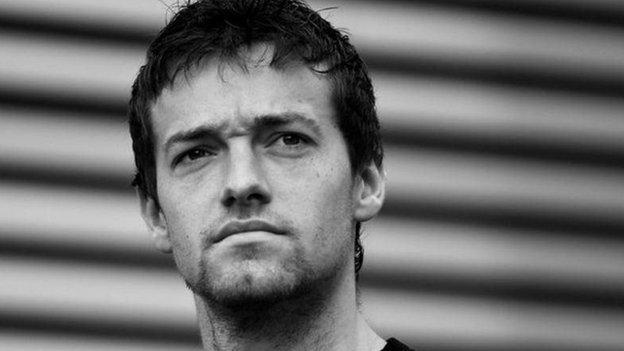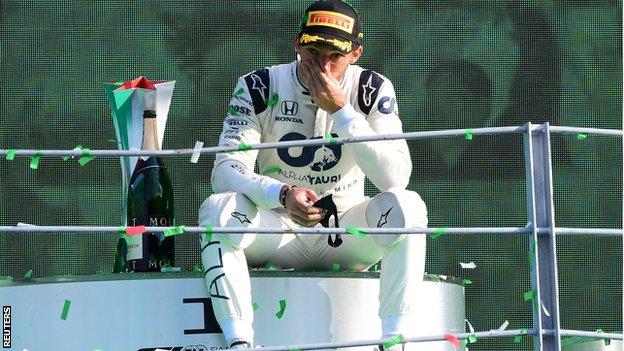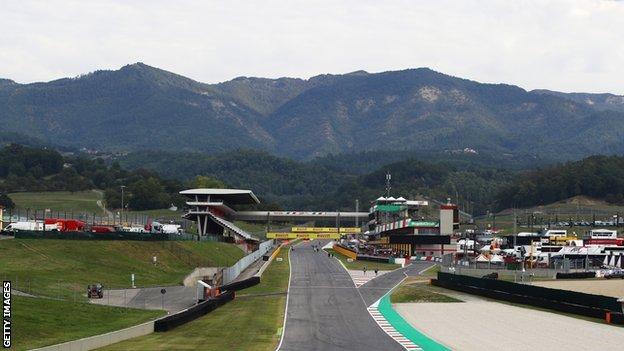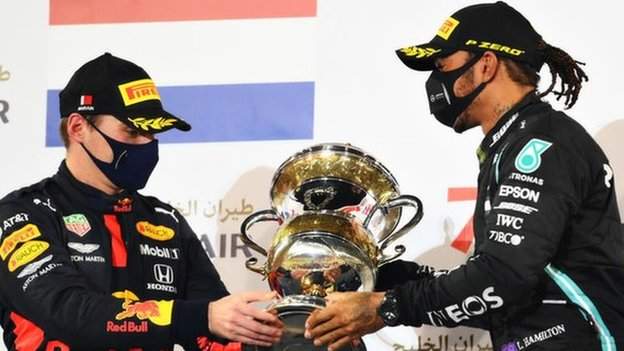
By Jolyon PalmerFormer Renault driver
Last updated on .From the section Formula 1

Former F1 driver Jolyon Palmer, who left Renault during the 2017 season, is part of the BBC team and offers insight and analysis from the point of view of the competitors.
The strangest Formula 1 season, in the strangest year, has come to an end.
Lewis Hamilton was so good the competition at the front left something to be desired, but the year was full of action, interest and intrigue nonetheless.
This is my rundown of the standout aspects of F1 in 2020 – a season full of surprises, incidents and drama.
The standout drivers
Hamilton had an exceptional season, and his dominance made the running at the front more predictable than F1 and the fans would have liked.
The Mercedes driver won 11 of the 16 races he took part in. Incredibly, though, that is underplaying how dominant he really was.
Hamilton was denied two certain victories by incurring penalties in Monza and Russia. And he may not have been back to his fighting best in Abu Dhabi for the season finale after contracting coronavirus and missing the second Bahrain race.
Given that, Hamilton could have won 13 of the 15 races in which he was able to properly compete.
It was an astonishing level of superiority.
With Mercedes on a different level to every other team in terms of car performance, many of Hamilton’s wins came from pole position.
But even when he was not on pole, he could fight back and pass team-mate Valtteri Bottas on track, which he did at both the Nurburgring and Portimao.
His best drive was undoubtedly his championship-clinching win in Turkey. This was surely one of his best career wins on a weekend when Mercedes were not at their dominant best.
Becoming statistically the best driver in history – after matching Michael Schumacher’s seven titles and beating his 91 wins – is the reward for a phenomenal season.
Excellent as Hamilton was, though, separating his performances and those of Red Bull’s Max Verstappen is as hard as it was last year.
Verstappen will be an F1 champion in the future. He just needs the tools to be able to do it, and arguably he needs Hamilton to retire for that chance.
Once again the Dutchman has driven an exemplary season, taking two wins and only making one major mistake all year – a 360-degree spin in Turkey costing him a chance of victory. It was the only race he completed outside the podium places all season.
In fact, Verstappen was very unlucky not to finish second in the standings, splitting the drivers in the faster Mercedes. He had too many mechanical retirements, which cost him a huge haul of points. For the second season in a row, he completely took apart his team-mate, in this case Alex Albon.
Albon failed to get within 0.3 seconds of Verstappen in any qualifying session in 2020. Red Bull were effectively a one-car team, with Verstappen demonstrating what a world-beating driver can do.
All in all, I think there was little to choose between Hamilton and Verstappen in terms of what they achieved in the year, given their machinery.
There were brilliant seasons for other team leaders as well, though.
Charles Leclerc was outstanding for Ferrari, almost trebling the points total of team-mate Sebastian Vettel and delivering some exquisite qualifying laps and measured race performances, culminating in two podiums in a Ferrari that didn’t deserve to be there.
Were it not for crashes into his team-mate in Austria, and Sergio Perez in Sakhir, I’d put Leclerc in the top bracket with Hamilton and Verstappen. He clearly deserves to be in a car that can compete for wins.
Perez also had a terrific year for Racing Point, as did Daniel Ricciardo in his final season for Renault. Both emerged as major players in the tight midfield and fought for fourth in the drivers’ standings.
Perez was fighting for a 2021 seat and barely put a foot wrong in the second half of the season, with a win and a second place the highlights as he claimed fourth position, a career high for the Mexican.
Ricciardo didn’t have the highs of Perez, but the way he outperformed Esteban Ocon in the Renault was very impressive.
Ocon is a highly rated young driver who has been tipped for great things and showed flashes of that potential in 2020. But Ricciardo was clearly the stronger. He out-qualified Ocon in every dry qualifying until the last race and was constantly up the road in races.
Underdogs go for gold
Shock wins are the sort of thing that typically happen once a decade in F1 – think Pastor Maldonado winning the Spanish Grand Prix for Williams in 2012, or Sebastian Vettel’s triumph in the wet at Monza in 2008.
But with all the craziness in 2020, two came along at once.
The first was Pierre Gasly at the Italian Grand Prix – only the second ever win for the team formerly known as Toro Rosso, after Vettel’s 2008 triumph.
The victory came from a Mercedes blunder, as they told Hamilton to stop for tyres when the pit lane was closed. That incurred a penalty the champion couldn’t recover from.

Another Mercedes blunder was the source of the other surprise win of 2020, as a botched pit stop cost the team a certain one-two finish, and George Russell a win in Sakhir.
Perez took the victory in a thrilling race – coming from last on the first lap to win, passing numerous cars on his charge through the field, capitalising on a bad day for the usual contenders.
It wasn’t only a season for shock victories, though.
Incredibly, the top 13 drivers in the championship all stood on the podium at some point (and even 14th-placed Daniil Kvyat came close, finishing fourth in Imola). The last time that happened was in 2012. In the past decade there have typically been about eight different podium finishers a season.
This just illustrates how wide open the championship was behind the dominant Mercedes and Verstappen. As soon as they hit problems, there was always going to be a new face on the podium, and so often that face was different.
It’s also down to the struggles of Albon in the other Red Bull and the demise of Ferrari, who traditionally would be blocking out those places, but were reduced to scrapping in the midfield themselves this season.
New races on old circuits
A year in which the pandemic forced the calendar to be fluid gave a chance to have grands prix in countries that normally couldn’t dream of affording them, at circuits that otherwise certainly merit a spot.
The return of Nurburgring, Imola and Istanbul, mixed with debuts for Mugello and Portimao, provided a lot of unknowns and surprises.
Having new circuits on the calendar is usually interesting, but the major benefit of these ones – aside from Turkey – was they weren’t specifically designed to host modern F1, so aren’t built with gigantic run-off areas and the same design mould of huge straights and big braking zones.
That meant rather than having the soulless atmosphere of many modern circuits, they were good, old-fashioned tracks with jeopardy, where mistakes were punished. Having them on the calendar was an undoubted success.
The string of accidents in Mugello, Verstappen being stuck in the gravel in Imola, or even Russell hitting the wall under the safety car there, are all things that probably would not have happened on the modern circuits.

Add in the fact I think the two best races were at two ‘new’ tracks – a slippery Istanbul, which always was one of the best ‘modern’ circuits anyway, and the untested Bahrain outer loop – and this was a season where the risky, much-changed calendar added a breath of fresh air.
With Abu Dhabi, Sochi and Barcelona providing relatively little action as usual, returning to some old-school circuits was a kind of grand experiment. And it worked a treat.
A mammoth achievement by F1
Getting a season off the ground at all in 2020 was a tricky task for such a global sport.
When coronavirus hit, the calendar had to be completely abandoned and almost entirely created from scratch, and F1 had to think about the coronavirus measures it could put in place to get back under way – keeping the paddock a safe place to work for all personnel.
Numbers were cut, bubbles were formed and extremely strict protocols were created to ensure the championship could get through 17 races around the world, with more than 1,300 travelling personnel.
There were a few coronavirus cases, most notably for Hamilton, but the fact the F1 circus managed to continue without any further interruption is credit to the measures put in place, and the people involved for adhering to them.
The season itself wasn’t the thriller that had been hoped for. But looking beyond the dominance of the big three of Mercedes and Verstappen, there were so many iconic moments.
Hamilton winning the British Grand Prix on three wheels, Romain Grosjean stepping out of the fire in Bahrain, Russell looking top class when he ran in race-winning machinery for the first time, and those surprise wins.
Those moments, along with Hamilton breaking F1’s all-time records, will live long in the memory even if the season itself was not a classic in racing or competition terms.


